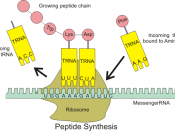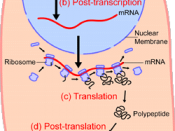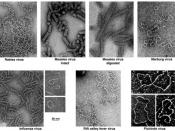Proteins are not built directly form genes. The working instructions of the genes are made of molecules of ribonucleic acid, or RNA. RNA, like DNA, is a nucleic acid. It differs from DNA in 3 ways. First, RNA consists of a single strand of nucleotides instead of the two strands that form the double helix. Second, RNA contains the five-carbon sugar ribose rather than the sugar deoxyribose. And third, RNA has a nitrogen-containing base called uracil - abbreviated as U - instead of the base thymine found in DNA. Like thymine, uracil is complementary to adenine.
All three types of RNA, are essential for processing the information from DNA into proteins, a process called gene _expression. Gene _expression occurs in two stages - transcription and translation. In transcription, the information in DNA is transferred to mRNA. In translation, the information in mRNA is used to make a protein.
After transcription, the genetic message is ready to be translated form the language of RNA to the language of proteins.
The instructions for building a protein are written as a series of three-nucleotide sequences called codons. Each codon along the mRNA strand either corresponds to an amino acid or signifies a stop signal.
From trial-and-error experiments, biologists worked out which codons correspond to which amino acids. In 1961, Marshall Nirenberg, an American biochemist, deciphered the first codon by making artificial mRNA that contained only the base uracil.
The equipment for translation is located in the cytoplasm, where a cell keeps its supply of transfer RNA (tRNA). A tRNA molecule is a single strand of RNA folded into a compact shape with three loops. One of the loops has a three-nucleotide sequence called an anticodon.
Although rare, changes in an organism's hereditary information can occur. A change in the DNA of...



Biology notes...
While this paper would be slightly complicated for a beginner to understand, nonetheless, it is an informative collection of notes for readers. Good Job.
3 out of 3 people found this comment useful.